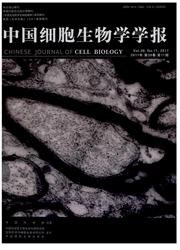

 中文摘要:
中文摘要:
研究新合成的一氧化氮供体嘲苷衍生物6-甲基-4-(2-氟-3,5-二-O-苯甲酰基-1-B—D-呋喃阿拉伯糖)-【1,2,5】噁二唑[3,4-d】嘧啶-5(4H),7(6H)-二酮1-氧化物(MOPDO)抑制人肝癌细胞HepG2增殖、诱导凋亡的作用。以不同浓度的MOPDO作用于人肝癌细胞HepG2,MTT检测与相差显微镜观察相结合,分析MOPDO对HepG2细胞增殖的影响;膜联蛋白-V/PI双染检测细胞凋亡率;JC-1染色检测线粒体膜电位(△ψm)变化;硝酸酶法测定细胞培养液中NO的含量。结果发现,MOPDO以时间和剂量依赖性方式抑制HepG2细胞的增殖,细胞形态出现相应的变化;细胞凋亡率的增加呈时-效和量.效关系;JC—1染色显示,线粒体膜电位随着MOPDO剂量的增加降低;MOPDO释放的NO量呈剂量依赖性增加。表明线粒体可能参与介导MOPDO抑制HepG2细胞的增殖、诱导其凋亡的作用。
 英文摘要:
英文摘要:
To investigate the anticancer effect of a newly synthesized 6-Methyl-4-(2-fluoro-3,5-di-O- benzoyl-1-β-D-ribofuranosyl)-[1,2,5]-oxadiazo[3,4-d]pyrimidine-5(4H),7(6H)-dione 1-oxide (MOPDO), a nitric oxide donating-compound derivated from nucleotide analogue, in human hepatoma cell line HepG2. Cell proliferation was assessed by MTT assay and morphological observation. Cell apoptotic rate was detected by flow cytometry (FCM) following annexin-V/PI staining. Mitochondrial membrane potential was observed by fluorescence microscopy with JC-1 loading. NO levels were measured by quantifying the content of nitrite and nitrate in the cell culture medium. The results showed that MOPDO inhibited the HepG2 cell viability significantly in a both concentration- and time-dependent manner. Apoptosis properties were observed, as characterized by annexin-V/PI double staining, showing that apoptotic rate increased in a concentration- and time-dependent manner. Moreover, MOPDO caused a loss of mitochondrial membrane potential in a dose-dependent manner. In addition, NO assay indicated that MOPDO elevated NO level in a concentration-dependent manner. The above data indicated that mitochondria might be involved in mediating the MOPDO-induced proliferation inhibition and apoptosis in HepG2 cells.
 同期刊论文项目
同期刊论文项目
 同项目期刊论文
同项目期刊论文
 Both DNA Damage and Mitochondrial Dysfunction Were Involved in Novel Oxadiazolo[3,4-d]pyrimidine Nuc
Both DNA Damage and Mitochondrial Dysfunction Were Involved in Novel Oxadiazolo[3,4-d]pyrimidine Nuc 期刊信息
期刊信息
